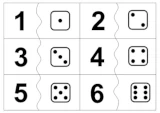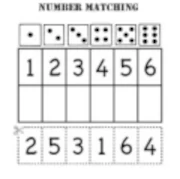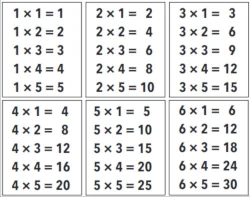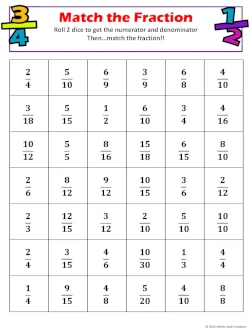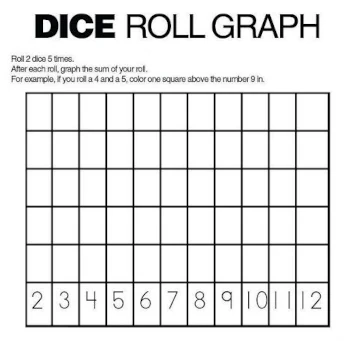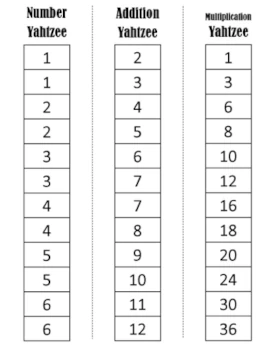Teach Math with Yahtzee
Most modern tabletop and board games aren’t interested in teaching you anything. That’s where Yahtzee is different. Yahtzee’s number-based gameplay system is the perfect delivery method for teaching math. From basic math skills like matching and counting to advanced concepts such as probability, statistics, and game theory, Yahtzee is a great addition to the math teacher’s repertoire. It's math made fun!
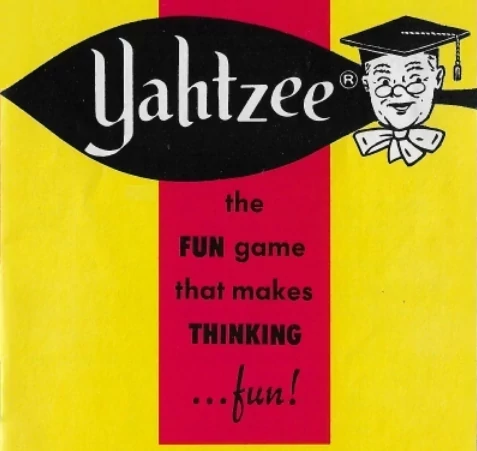
A collective groan annually cascades around the world as summer vacation nears its inevitable end. But the back-to-school season doesn’t have to lead to misery and toil. Students and teachers alike can keep the good times rolling by playing Yahtzee at school. Don’t worry, it’s not a sign of delinquency or disinterest – in fact, just the opposite. Yahtzee is a powerful tool to teach math skills in a fun and engaging way.
Math Yahtzee has a long history in supplemental learning. In fact, the original 1956 set was marketed as “the game that makes thinking fun.” The tagline was eventually replaced with snappier language but Yahtzee’s performance as a mathematics explorer remains unparalleled. As a classic numbers game, it can be used to teach math students of all ages, from preschool aged kids through to adults. Standard gameplay involves a variety of mathematical concepts that can be used to illustrate techniques like counting, adding, and other basic skills to more complex ideas like probability and statistics.
Yahtzee is one of the few games that can be truly enjoyed by players of all ages. As a rare example of a board game with a broad intergenerational fanbase, its potential to boost math skills among a large swathe of the population is likewise vast. Do your students find math not fun? Educators can exploit Yahtzee’s popularity to reinforce an array of math skills to learners at all levels.
Transform "Math Not Fun" into "Math Made Fun"
Struggling with math? Yahtzee is the perfect solution for making learning math feel like a fun, exciting game! With its engaging gameplay, Yahtzee turns “math not fun” into “math made fun” for players of all ages.
By integrating key math concepts like place value and probability into the game, Yahtzee encourages players to think critically and improve their math skills while having fun. This “Yahtzee cool math games” approach makes learning more dynamic and hands-on.
Whether it's mastering place value or understanding basic operations, place value Yahtzee offers a creative way to reinforce math skills in an environment that feels far from the typical classroom setting. Get ready to roll the dice and discover how Yahtzee makes math both fun and educational!
A Math Yahtzee Curriculum
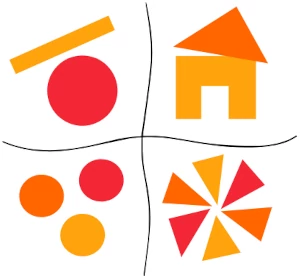
When using Yahtzee as a teaching aid, it is important to clearly communicate the game’s structure and its relation to mathematical concepts, especially for younger learners. Begin each lesson with a standard overview that covers the major topics in an engaging way:
- Reinforcement:Reinforce the definition of the mathematical concept by stating, for example: "Addition is the joining of two or more numbers to get one number called the sum."
- Explanation:Introduce Yahtzee and explain the rules of the game. Be sure to answer questions and repeat as necessary.
- Show & Tell:Model how to play Yahtzee. Focus on the game mechanics and recording scores on the scorecard.
- Rolling dice:Model how to use the dice properly. Encourage small rolls that stay on the table or risk dice flying everywhere and children spending more time retrieving dice than playing the game.
- Repetition:Reinforce the definition of the mathematical concept during gameplay and assist the students in identifying it in practice.
The idea that practice, reinforcement, and repetition are the keys to an effective teacher-learner relationship is rooted in educational research. When students practice math skills through repetition and reinforcement, they have the opportunity to internalize the concepts and make them a part of their long-term memory. This is why many math teachers emphasize the importance of consistent practice and repetition.
Yahtzee's dual nature as a game that combines both rational numbers and a fun and engaging experience is what makes it such an effective tool for teaching math. By incorporating math skills into the game, students can learn while having fun and not even realizing they are practicing math. This helps to build their confidence and motivation to learn. Studies have shown that using games in the learning process can significantly increase outcomes, including higher exam scores and better grades.
In addition to practice, repetition, and reinforcement, Yahtzee also helps to develop problem-solving skills and critical thinking. The game requires players to use their math skills to make strategic decisions, and this can help to strengthen their ability to think critically and solve problems.
Add it Up
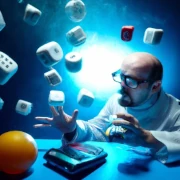
Yahtzee is a game that can be used to teach a variety of mathematical topics. As a game that involves rolling dice, adding and subtracting numbers, and making strategic decisions, it can be adapted to cover many different math concepts. The flexibility of Yahtzee makes it an excellent tool for teachers and educators looking to engage students in learning math. By incorporating mathematical concepts into a fun and engaging game, students can learn in a way that is enjoyable and memorable. This can help to build their confidence and motivation to continue learning math in the future.

Counting
The basis of mathematical understanding is an ability to count numbers in sequence. Since Yahtzee is built upon a foundation of counting numbers, they are a variety of ways to reinforce the skill through game play.
The youngest math learners can practice counting using the pips on a die. Have them roll a single die and count the dots to determine the number. Increase the number of dice as needed. Gradually move up to skip counting, or counting by intervals other than one, as a more advanced technique. Calculating the Upper Section Bonus is a natural way to introduce the concept. Count by threes, for example, to figure the possible scoring opportunities in that category: 3, 6, 9, 12, 15.

Subitizing
One of the most basic math skills that can be taught with Yahtzee is the ability to subitize, or instantly recognize how many objects are in a small set. Dice provide a perfect example of subitizing in action; when you roll a die and you see four dots on top, you immediately recognize it as representing a quantity of four. You don't need to count each dot on the die face to figure it out – it’s obvious at a glance.
Subitizing allows for rapid, accurate, and confident judgments of numbers when performed for a small number of items. But once there are more than four items to count, judgments are made with decreasing accuracy and confidence. In addition, response times rise in a dramatic fashion, with an extra 250–350 milliseconds needed for each additional item within the display beyond about four. A similar pattern of reaction times is found in young children, although with steeper slopes for both the subitizing range and the enumeration range.
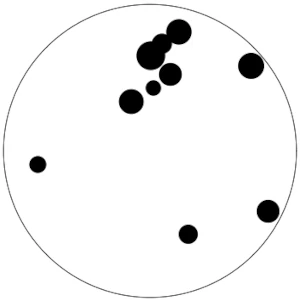
In the 1990s, babies three weeks old were shown to differentiate between one to three objects, that is, to subitize. By the age of seven that ability increases to between four and seven objects. But subitization is also used to help organize very large numbers. One of the most basic applications is in digit grouping in large numbers, which allow one to tell the size at a glance, rather than having to count. For example, writing one million as 1,000,000 instead of 1000000 acts to divide the number into smaller units, making it much easier to read quickly.
Young children will benefit most from subitizing exercises. At this age, rolling an entire game of Yahtzee is not required – you just want to get the kids familiarized with dice mechanics and identifying small number sets. Practice makes perfect – keep them rolling dice and shouting out numbers to flex their subitization muscles. Use a simple scorecard for students to record their numbers.
Subitizing allows students to move away from counting by ones to seeing numbers as chunks and is a vital skill to master in a child’s early mathematics development. The pips on dice are a great example of an organized or structured arrangement. Kindergarten and 1st graders will benefit from daily Yahtzee instruction all year long.

Matching
As a child is mastering subitizing small numbers, new skills can be introduced. Simple number recognition is reinforced through matching. Have the players roll a die and identify the number as quickly as they can. They then roll a second die and determine if they have a match. Scale up with more dice and to make matches with specific scoring combinations, like the Full House.

Basic Mathematical Operations
The four basic math operations - addition, subtraction, multiplication, and division - form the backbone of higher algebraic studies and are integral to understanding Yahtzee.
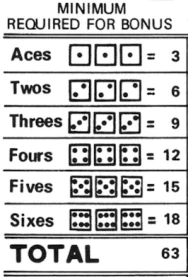
Addition
Yahtzee provides nearly endless opportunities for students to practice addition. Its game mechanics and scoring system require it. The Upper Section is a great place to get started since players need to record a sum on their scorecards. And then those sums are themselves summed to compute the Upper Section Total. Three-of-a-Kind, Four-of-a-Kind, and Chance are the Lower Section opportunities to practice adding numbers. And of course the ultimate addition task awaits players at the end of the game when they must tabulate their total scores.
Subtraction
The challenge of securing the Upper Section Bonus is a chance to practice subtracting one number from another. The goal in the Upper Section is to score at least 63 points, which will unlock a 35-point bonus. A careful player will frequently subtract their running total from the 63-point target, ensuring that they will remain on track for the bonus.
Multiplication
Although it can be scored with any combination of numbers that equal at least 63 points, the Upper Section Bonus averages out to three of each number, one through six. Players can use multiplication to figure their totals. Instead of adding three plus three plus three, for example, encourage students to work more efficiently by calculating the product instead. This can be a helpful way to reinforce multiplication tables through a Yahtzee game.
Division
Division is the rarest of the basic math operations to be called upon during a game of Yahtzee. This may be a result of the ideals of unity and compassion that are inherent to the game. Yahtzee is a uniter, not a divider. Nevertheless, division can prove to be a useful tool in the Yahtzee enthusiast’s mathematical toolkit. While it is seldom required during gameplay, calculating quotients is extremely useful to the study of Yahtzee on a deeper level. More advanced math techniques like probability and statistics use division to devise data-driven tools that can improve a player’s Yahtzee strategy.

Probability
Probability is a mathematical conceit of how likely something is to happen. The study of this branch of mathematics is very useful in a numbers game like Yahtzee. Players who compare their own scoring tenancies with those of other players can identify weaknesses in their games and develop new tactics. Yahtzee odds are a key source of a sound strategy but players should be encouraged to explore a variety of styles as they develop a new gameplan.
Unsurprisingly for a game with a scoring category called ‘Chance’, a Yahtzee game packs a plethora of probability possibilities. But most players get excited by the namesake, the Yahtzee itself. Learning to calculate the likelihood of getting a Yahtzee in a single roll is an engaging way to introduce students to the power of probability. Bowling Green State University is one institution that uses Yahtzee odds in introductory statistics courses:
Probability of a Yahtzee
Each die has six possibilities and so by applying the multiplication rule, the total number of outcomes in the roll of five dice is:
6 × 6 × 6 × 6 × 6 = 7776
Since all of the outcomes are equally likely, we assign a probability of 1/7776 to each outcome.
We can represent the Yahtzee roll as the outcome:
x, x, x, x, x
where x denotes an arbitrary roll of one die. There are six possible choices for x, and so the number of possible Yahtzees is 6.
Since each outcome has probability 1/7776, the probability of a Yahtzee is:
Prob(Yahtzee) = 6/7776
or 0.077%

Statistics
Statistics is the study of the collection, organization, analysis, interpretation, and presentation of data. A game of Yahtzee provides a treasure trove of juicy data just waiting to be probed and analyzed. Game data like the frequency of scoring a Large Straight or average Chance score will shed light on a player’s strategy and priorities. Use these insights to teach students about their statistical underpinnings and help to increase high scores all at once.
Statistics touches on all aspects of data. Once the hard work of collection and analysis is complete, seeing the results presented visually provides a satisfying sense of accomplishment. A fun and educational way to display Yahtzee data is with dice graphing.
Dice Graphing
As we have seen, all of the major mathematical concepts found in Yahtzee can be explored in the Upper Section of the official scorecard. Take it a step further and have students practice graphing using the upstairs alone. Rather than playing with the whole Yahtzee score sheet, simply use the Upper Section of the game card. Have each player roll one time and mark how many of each die they roll. Then create a graph to chart the frequency of numbers in players’ rolls.
Yahtzee: Math Made Fun!
Yahtzee is a great way to teach math for a variety reasons:
- It uses probability and statistics: Yahtzee involves rolling dice and calculating the probability of certain combinations. This can help to teach basic concepts of probability and statistics.
- It encourages strategic thinking: Yahtzee requires players to think strategically about which combinations to aim for and how to score the most points. This can help to develop problem-solving and critical thinking skills.
- It involves mental math: Yahtzee requires players to add and subtract numbers, which can help to develop mental math skills.
- It can be adapted to different math concepts: Yahtzee can be adapted to teach a variety of math concepts such as fractions, decimals, and percentages.
- It is a fun and engaging way to learn: Yahtzee is a game that is enjoyable to play, which can make learning math concepts more engaging and less intimidating for students.
- It can be used across different grade levels: Yahtzee can be used to teach math concepts for students of different grade levels, from elementary school to high school.
- It is available in a wide variety of electronic forms like mobile phone apps and computer games, simplifying the introduction of Yahtzee into an online learning curriculum.
An electronic calculator may be tempting when tallying the scorecard, but doing daily mental calculations can help keep our minds sharp as we age. Digital math assistance should be limited to double-checking final scores or rooting out those who dare to cheat at Yahtzee. When basic math ability starts to slip, that’s when mistakes happen. Take care to maintain razor sharp addition skills or risk faux pas-ing your way into social oblivion with a miscalculated Chance score.
To enjoy Yahtzee is to enjoy – or at least tolerate – math. Not everyone is going to need advanced calculus in their lives, but a solid comprehension of the fundamental math skills found in Yahtzee is a critical component of basic education.
Teachers and math tutors should feel encouraged to use Yahtzee to teach math. Either standard rules or a Yahtzee math game will provide results for both at-school and home-schooled kids. And thanks to a continuing surge in electronic and online Yahtzee games even distance learning students can participate. There are even more great resources online to find other ways to incorporate dice into learning math. For example, Kate’s Homeschool Math Help shares tips for simplified Yahtzee games to play with young pupils:
How to Play
- Number Yahtzee: Roll one die when it’s your turn. Cross off the number that matches the die.
- Addition Yahtzee: Roll two dice when it’s your turn. Cross off the number that matches the sum of the two dice.
- Multiplication Yahtzee: Roll two dice when it’s your turn. Cross off the number that matches the product of the two dice.
- If you have already crossed off the number that matches the dice, you don’t get to cross anything off. (It can take a while to get some of the numbers - kids learn a lot about probability in waiting to get that final combination!) The first person to cross off all of the numbers on their game board wins.
Often, the perception of mathematics as difficult and daunting creates a barrier for young learners. This societal bias can form a self-fulfilling prophecy, causing students to approach math with apprehension, and consequently impede their learning journey. However, incorporating engaging games like Yahtzee into the learning process can fundamentally transform these negative associations. Yahtzee not only makes math enjoyable but also simplifies complex mathematical concepts, making them more approachable for students. Just as in Yahtzee and life, an unbiased and open-minded approach towards math can pave the way for success and happiness. Remember, while some may find math challenging, others thrive in numerical environments. Thus, let's debunk the myth - math isn't always hard; sometimes, it's simply about finding the right approach to learning it. Yahtzee is math made fun!


